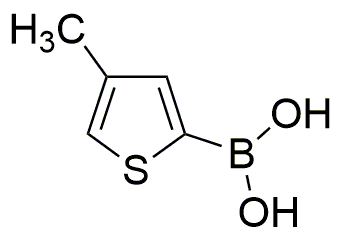4-Methyl-2-thiopheneboronic acid is widely utilized in research focused on:
- Organic Synthesis: This compound serves as a crucial building block in the synthesis of various organic molecules, particularly in the development of pharmaceuticals and agrochemicals.
- Cross-Coupling Reactions: It is commonly used in Suzuki-Miyaura coupling reactions, allowing researchers to create complex carbon-carbon bonds, which are essential in the formation of advanced materials.
- Sensor Development: The unique properties of this boronic acid make it ideal for developing sensors that detect sugars and other biomolecules, benefiting the food and healthcare industries.
- Material Science: It is employed in the creation of conductive polymers and materials, enhancing the performance of electronic devices and renewable energy technologies.
- Medicinal Chemistry: Researchers utilize it in drug discovery processes, particularly for targeting specific biological pathways, leading to more effective treatments with fewer side effects.
General Information
Properties
Safety and Regulations
Applications
4-Methyl-2-thiopheneboronic acid is widely utilized in research focused on:
- Organic Synthesis: This compound serves as a crucial building block in the synthesis of various organic molecules, particularly in the development of pharmaceuticals and agrochemicals.
- Cross-Coupling Reactions: It is commonly used in Suzuki-Miyaura coupling reactions, allowing researchers to create complex carbon-carbon bonds, which are essential in the formation of advanced materials.
- Sensor Development: The unique properties of this boronic acid make it ideal for developing sensors that detect sugars and other biomolecules, benefiting the food and healthcare industries.
- Material Science: It is employed in the creation of conductive polymers and materials, enhancing the performance of electronic devices and renewable energy technologies.
- Medicinal Chemistry: Researchers utilize it in drug discovery processes, particularly for targeting specific biological pathways, leading to more effective treatments with fewer side effects.
Documents
Safety Data Sheets (SDS)
The SDS provides comprehensive safety information on handling, storage, and disposal of the product.
Product Specification (PS)
The PS provides a comprehensive breakdown of the product’s properties, including chemical composition, physical state, purity, and storage requirements. It also details acceptable quality ranges and the product's intended applications.
Certificates of Analysis (COA)
Search for Certificates of Analysis (COA) by entering the products Lot Number. Lot and Batch Numbers can be found on a product’s label following the words ‘Lot’ or ‘Batch’.
*Catalog Number
*Lot Number
Certificates Of Origin (COO)
This COO confirms the country where the product was manufactured, and also details the materials and components used in it and whether it is derived from natural, synthetic, or other specific sources. This certificate may be required for customs, trade, and regulatory compliance.
*Catalog Number
*Lot Number
Safety Data Sheets (SDS)
The SDS provides comprehensive safety information on handling, storage, and disposal of the product.
DownloadProduct Specification (PS)
The PS provides a comprehensive breakdown of the product’s properties, including chemical composition, physical state, purity, and storage requirements. It also details acceptable quality ranges and the product's intended applications.
DownloadCertificates of Analysis (COA)
Search for Certificates of Analysis (COA) by entering the products Lot Number. Lot and Batch Numbers can be found on a product’s label following the words ‘Lot’ or ‘Batch’.
*Catalog Number
*Lot Number
Certificates Of Origin (COO)
This COO confirms the country where the product was manufactured, and also details the materials and components used in it and whether it is derived from natural, synthetic, or other specific sources. This certificate may be required for customs, trade, and regulatory compliance.


